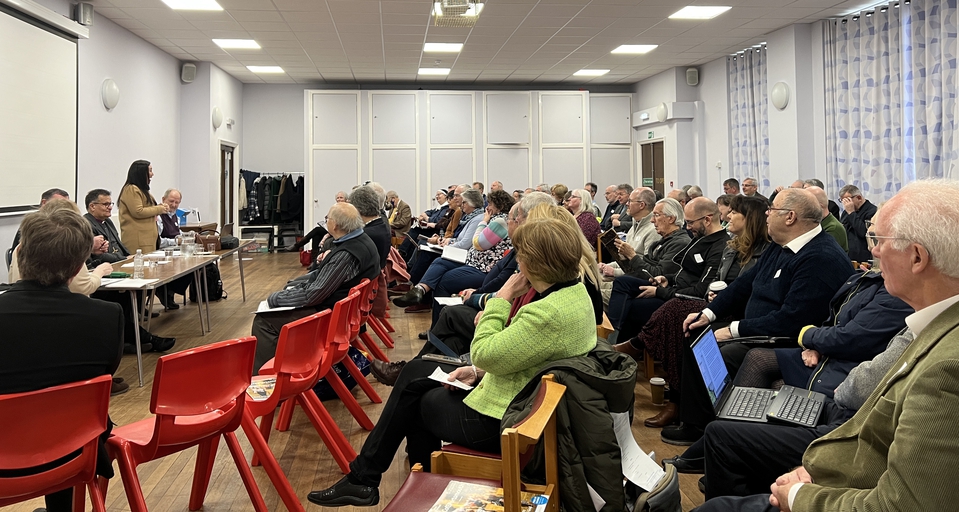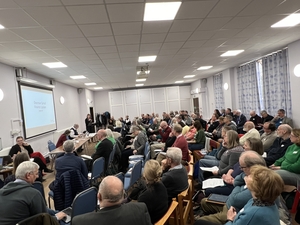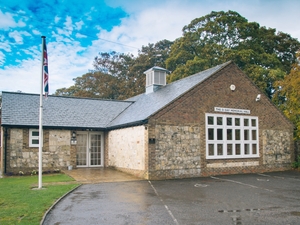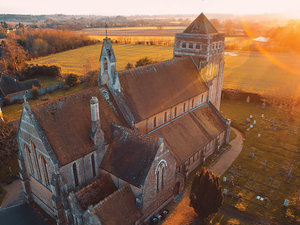Diocesan Synod, March 2023
PRESIDENTIAL ADDRESS
Bishop Jonathan gave his Presidential Address during the Eucharist. It included an introduction to the seven deanery plans which would be presented during the synod meeting, and also some thoughts after the General Synod’s debate about the bishops’ proposals relating to Living in Love and Faith. You can read it here.
SAFEGUARDING
Safeguarding manager Emily Hassan updated synod members. She reported that:
- the new safeguarding case management system, MyConcern, was a strong alternative to the current system;
- the number of outstanding cases after the Past Cases Review 2 (PCR2) process was shrinking, and various learning outcomes were being recorded as a result;
- some of the recommendations of the PCR2 independent reviewers would involve re-doing police investigative work, which the Diocesan Safeguarding Advisory Panel (DSAP) agreed was beyond the scope of the safeguarding team;
- the National Clergy Register is designed to be a public database confirming that those who say they are clergy are indeed licensed for ministry. We still have some outstanding questions about what happens on that database if a clergy person is suspended, pending a complaint being investigated.
FINANCE MANAGEMENT ACCOUNTS
Interim Diocesan Secretary Philip Poulter presented our management accounts to 31 December 2022, which you can read here. Among other things, he noted that the auditors were looking again at how often we revalue our properties. Every year we revalue 20% of our properties, which is all we have the resources to do, but our auditors would like us to revalue 100% of our properties each year.
Philip addressed the failure of the old budgeting system, which, in the past three years predicted seven-figure deficits, only for the actual deficits to be much smaller. This has been addressed for the 2023 budget, produced for the first time by financial controller Elaine Aplin, who is also working with each department to ensure the budgeted figures are correct.
DEANERY VISION AND PLANS
Each of our seven deaneries gave an update on progress with their deanery plans.
1. BISHOP’S WALTHAM:
Lay chair Norman Chapman gave a presentation which you can see here. Among the deanery’s priorities are to inspire deeper personal discipleship, transformational worship, a focus on young and old, and a re-purposing of church buildings. Key areas to be explored included demography, worship styles, community links, buildings and facilities, and finances.
In terms of ministry provision, the deanery plan envisaged one priest for the Meon Bridge/Swanmore/Soberton, Newtown and Hambledon area, alongside three House for Duty priests.
2. GOSPORT:
Area dean Paul Chamberlain gave a presentation, which can be seen here. He explained that until recently, Gosport deanery was eight parishes, but a pastoral reorganisation in 2018-20 had reduced that to four.
New parishes had been created in North Gosport (Bridgemary, Elson and Rowner) and South Gosport (Christ Church, Holy Trinity and Forton), which had used some SDF funding to create new worshipping communities and to revitalise more traditional congregations. That funding had been used on children/youth worker, operations manager and pioneer roles. Among new ministries was St Matt’s on the Corner café in Bridgemary and the Kitchen Table meals for needy families in Christ Church.
There was also some whole-deanery work going on with children, families and young people, and Anna Chaplaincy. The changes the deanery had faced weren’t always easy, but there was fruit in terms of people coming to faith, growing church communities and real engagement with the wider community.
3. FAREHAM:
Area dean Ian Meredith and vicar of Warsash Mike Terry gave a presentation, which you can see here. They said Fareham deanery is now 10 parishes, including the new parish of Whiteley. It’s mainly suburban, but each parish has some deprivation. The population will reach 125,000 by 2030. The new town of Welborne will be 15,500 people by 2045.
The Fareham deanery roadmap envisages a network of strong, collaborating churches, with an emphasis on children, young people and young adults and on Anna Chaplaincy. There is work to do on developing deanery synod, and to ensure any new parish of Welborne has a vicar, vicarage, church and church building. Among the different models of collaboration would be:
- Covenanted partnership (Western Wards of Fareham);
- Network connection (Crofton and Whiteley)
- Ecumenical relationship (Fareham town centre churches)
- Contributing parish (Portchester, resourcing others)
4. PORTSMOUTH:
Area dean Bob White told synod members that the Portsmouth deanery plan had flexed and evolved as diocesan priorities altered. But it was primarily based on relationships, with 17 parishes (including the cathedral and the new Harbour parish) split into four clusters/areas.
Among the good work going on was the Bridgeway project, based at St Luke’s, Southsea. Vicar Annie McCabe explained this was created to help children and young people from the inner-city, who were five times as likely to have issues relating to mental health, social anxiety or drugs. This project aims to reach them with the love of Christ, working in the community alongside other agencies, and setting up a calm space in the church. This could be developed next in Fratton.
And Amy Webb, vicar of Cosham and Wymering, explained how the Cosham Larder had been set up two years ago in partnership with the city council, in a refurbished bowls pavilion. It offered fresh, affordable food to between 80 and 100 people each week, offering them food that supermarkets would have thrown out. It has expanded and a Little Larder had been created in St Philip’s Church, alongside a wellbeing café. The church is also drawing on pioneering principles to host fireside gatherings and Alpha Courses.
5. ISLE OF WIGHT
Archdeacon Steve Daughtery made a presentation, which you can see here. He presented the Isle of Wight deanery plan, which aims to enable its parishes to create realistic mission plans, to help people to grow in the depth of their discipleship and to increase the numbers of people in church communities.
How this is being done is as important as what is being done. So the idea is to model this in a collaborative way with clear leadership, listening to all, taking into account the local context, being generous to those who are different, and with plans that fit into the overall vision. So every benefice is developing its mission and strategy, and each parish in vacancy (half of them) has received a vacancy pack and is being walked through the vacancy process. Newport and Carisbrooke parish has asked for support from the diocese to help them to develop their SDF project and to appoint an interim team rector.
6. HAVANT
Area dean Andrew Sheard’s presentation can be viewed here. He said that below the deanery mission action plan are parish mission action plans, where most of the fruitfulness will be worked out. He gave two examples of where good things are happening:
In Horndean, there is no physical Anglican presence, as local churches are in Blendworth, Catherington and Cowplain. But there is Horndean C of E Junior School in the centre of this small town, and there’s an opportunity to grow a new worshipping community there that complements the surrounding parishes.
And in Berewood, the new town to the west of Waterlooville, there are 3,000 new homes and two primary schools. It’s an natural opportunity for a pioneer minister to help create a new worshipping community that complements local parish churches. The diocese has bought a house on the estate, and is changing parish boundaries. An appointment here could help kickstart Fresh Expressions in other parishes in the deanery.
7. PETERSFIELD
Lay chair Vanda Leary and area dean Susie Collingridge spoke about the priorities identified by Petersfield deanery, using this presentation.
Their aim is for churches to become praying communities, embedded in the life of their towns and villages, welcoming all and caring for their neighbours. They’ve embraced the idea of a deanery lead role, meaning that clergy will be asked to work a 70:30 split – 70% of their time for the parish and 30% in a deanery responsibility. This currently matches with their priorities as follows:
- Young people and schools (Liss) - NB: the Rev Clare Welham was announced as the new priest the day after synod
- Outreach to new communities (Sheet)
- Developing lay ministry (Hawkley, Greatham, Empshott and Priors Dean)
- Older people
- Refreshing worship and discipleship
- Building strong parishes
The deanery synod decided that Sheet and Liss were the deanery's priority appointments, and their application packs included this 70:30 split. The deanery lead role elements proved to be attractive. They are also retrofitting current roles that are already in place, not just new roles. Hence Peter Sutton has taken on the lay ministry brief.
BISHOP’S COUNCIL/DIOCESAN STAFF TEAM
Interim Diocesan Secretary Philip Poulter spoke about some of the decisions taken by Bishop’s Council, including action taken on parish share arrears, energy cost grants and hardship grants, as well as a proposal from Havant deanery about housing.
He also mentioned some of the challenges of the central staff team, where there has been some vacancies and medium-term sick leave among the admin staff. He mentioned that we will be applying for a new Director of Transformation, using SDF funding.
Bishop Jonathan spoke about the decision to close the Portsmouth Pathway, where our ordinands and Readers have been trained in partnership with Ripon College Cuddesdon since 2015. He stressed the quality of Richard Wyld’s ministry as director of Pathway and the residential weekends offered by Cuddesdon. But he outlined the financial challenges involved in paying for more places for ordinands and trainee Readers than we can fill. He said that switching to a range of different providers was not without pain or difficulty.
Director of mission and ministry Anthony Rustell added that the discussion was still continuing regarding whether the partnership with Cuddesdon would end in summer 2023 or summer 2024. But new ordinands and trainee Readers starting in September 2023 would go straight into the new arrangements, which would be tailored to the needs of the individuals involved.
EDUCATION TEAM UPDATE
Our joint Diocesan Board of Education switched in January 2023 to become a Charitable Incorporated Organisation (CIO), which made it separate from both dioceses, with its own set of trustees. Two of those trustees, Will Hughes and Lucy Docherty, made a presentation about education governance, which you can see here.
They outlined how new trustees would be elected by Diocesan Synods in Winchester and Portsmouth dioceses, and then appointed by the CIO. They would operate alongside one bishop’s appointee from each diocese and one archdeacon from each diocese. Anyone who was willing to become a trustee and has the necessary skills should contact director of education Jeff Williams. You can download an explanatory document here. More details about the governance issues are here.
They also updated synod members on issues such as the SIAMS inspection process, Growing Faith, and Everyday Ubuntu. And they talked about academisation – until recently it was government policy for every school to become an academy by 2030, but not any longer. However, new schools have to be academies, as do those that Ofsted deem ‘require improvement’ in two successive inspections, or ‘inadequate’ in any inspection. Our CIO is therefore creating a working party to ensure we have an academisation policy in place by the autumn.
GENERAL SYNOD UPDATE
General Synod member Bob White gave an update on the February meeting of the Church of England’s General Synod. As well as issues relating to gender and sexuality, it also:
- agreed a reduction in the increase in parochial fees
- considered an electronic services register, linked to annual parish returns
- agreed to allow dioceses/DBFs to use historic resources from other dioceses to fund stipends
- engaged in a debate about the cost-of-living crisis
- discussed the government exempting churches from insurance tax.
On the issues that got all the attention, there was one question (out of 100) to the Liturgical Commission asking if they might produce gender-neutral material that could be used by those who wish to do so. But that wasn’t the same as ‘making God gender-neutral’.
And the bishops’ proposals on same-sex blessings were considered in an eight-hour debate that was superbly chaired by Geoffrey Tattersall. Of the 19 amendments debated, only one was passed. And the substantive motion was passed in all three houses. Bob admitted that not only was General Synod divided, but so are our six General Synod representatives, 50:50. He said we needed to start looking at a new settlement, to explore how we continue in a journey of faith, acknowledging our differences, but finding ways to walk and live together.



